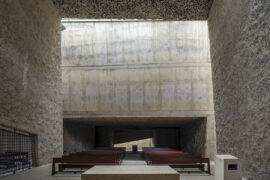Packed into The Mint in Sydney, a gathering – ‘argument’ is the correct collective noun – of architects provided a fascinating discussion on questions raised in Richard Francis-Jones’ book.

November 1st, 2023
If architecture events can sometimes underwhelm on the basis of the profession’s outward politeness and avoidance of controversy, this was very much an exception to the rule. Part lecture, part debate, part social gathering, ‘The Fencing of Architecture and the Villa of the Architect’ provided a genuinely stimulating and thought-provoking panel discussion.
It’s something the Australian architecture scene needs more of, which is all the more reason to be excited about the upcoming sequel. ‘The Consciousness of Architecture and the Will of the Architect’ is set to be the next instalment of the series which currently centres around Richard Francis-Jones’ ‘Truth and Lies in Architecture’.

Francis-Jones, design director and the ‘fj’ of fjcstudio, wrote the book during Covid lockdowns as a series of short, almost aphoristic essays on some of the most profoundly important issues facing architecture today. Here at Indesignlive, we applaud not only the depth of written engagement but also a continuation of the very debate it was designed to spark in the form of live events. Perhaps the book is to the event what a building is to its life after completion: full of unpredictable uses, sparks of creativity and inspirations, frustrations and a catalyst for debate.
The topics in question at the inaugural discussion were the archetypes of the fence and the villa. Francis-Jones opened with a lecture outlining his hypothesis that these two typologies, traceable back to classical times, have been damaging and alienating phenomena.

Related: Reviewing ‘Truth and Lies in Architecture’
We won’t do the topic justice here – you should read the book and attend the next event for that – but Francis-Jones’ argument goes something like this. The fence, as a means of demarcating private property from the shared, public world, has alienated us. We feel disconnected from the surrounding environment, whether human or natural, by virtue of a line on a map that says one side is our concern and the other is not. It’s a provocation that seems to owe something to Marx’s theory of primitive accumulation and recalls the enclosure of the commons in England, a historical process in which previously shared land was enclosed for the purposes of private ownership.
The discussion of course also raises the question of Indigenous understandings of Country. The sense of interconnectedness underpinning Country finds perhaps its polar opposite in the form of the fence.

As for the villa, its grandeur and prestige were again presented in the context of an object that seeks to sit outside of the public realm. Referring to historical examples, Francis-Jones suggested that the message of the private villa is one of sitting outside, over and above wider society. Perhaps the book’s sequel could be called ‘Alienation in Architecture’.
Following the opening lecture – which was itself preceded by a hearty selection of wines and cheese outside the auditorium – the panellists were invited to respond. They were Angelo Candelapas (Candelapas Associates), Hannah Tribe (Tribe Studio Architects) and Walbanga-Wadi Wadi artist Alison Page, while the discussion was moderated by Anthony Burke.

The list of stellar names didn’t end on the stage, however; Glenn Murcutt was in attendance and added some sharp points to the discussion. The next event, meanwhile, is set to feature Elizabeth Farrelly, William Smart and Shannon Foster.
With fjcstudio, the AIA, UTS and sponsored by Think Brick Australia, ‘The Consciousness of Architecture and the Will of the Architect’ will take place at The Mint, Sydney on 15th November, 2023.
fjcstudio
fjcstudio.com
Photography
Courtesy of fjcstudio





INDESIGN is on instagram
Follow @indesignlive
A searchable and comprehensive guide for specifying leading products and their suppliers
Keep up to date with the latest and greatest from our industry BFF's!

The undeniable thread connecting Herman Miller and Knoll’s design legacies across the decades now finds its profound physical embodiment at MillerKnoll’s new Design Yard Archives.

London-based design duo Raw Edges have joined forces with Established & Sons and Tongue & Groove to introduce Wall to Wall – a hand-stained, “living collection” that transforms parquet flooring into a canvas of colour, pattern, and possibility.

For Aidan Mawhinney, the secret ingredient to Living Edge’s success “comes down to people, product and place.” As the brand celebrates a significant 25-year milestone, it’s that commitment to authentic, sustainable design – and the people behind it all – that continues to anchor its legacy.

Your main seating can be a stylish centrepiece, not just a functional chair.

Hiwa, the University of Auckland’s six-storey recreation centre by Warren and Mahoney with MJMA Toronto and Haumi, has taken out Sport Architecture at the 2025 World Architecture Festival. A vertical village for wellbeing and connection, the project continues its run of global accolades as a new benchmark for campus life and student experience.

The World Architecture Festival has named The Holy Redeemer Church and Community Centre of Las Chumberas in La Laguna, Spain as World Building of the Year 2025, alongside major winners in interiors, future projects and landscape.
The internet never sleeps! Here's the stuff you might have missed

Community, Country and climate were centred at the 2025 Australian Institute of Landscape Architects (AILA) Awards in Lutruwita/Tasmania on 21st October.

A stunning indoor space reveals artistry in every aspect, from outlook to underfoot.